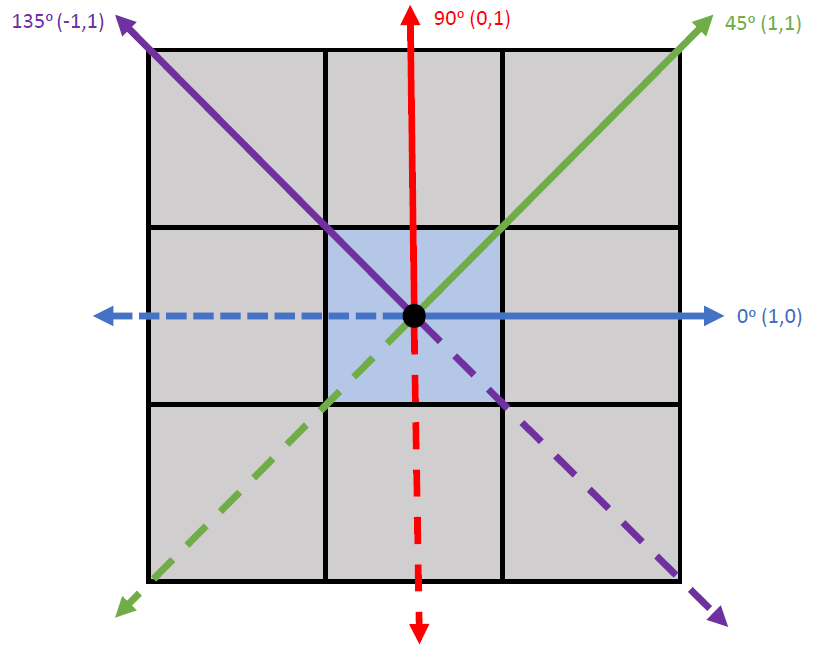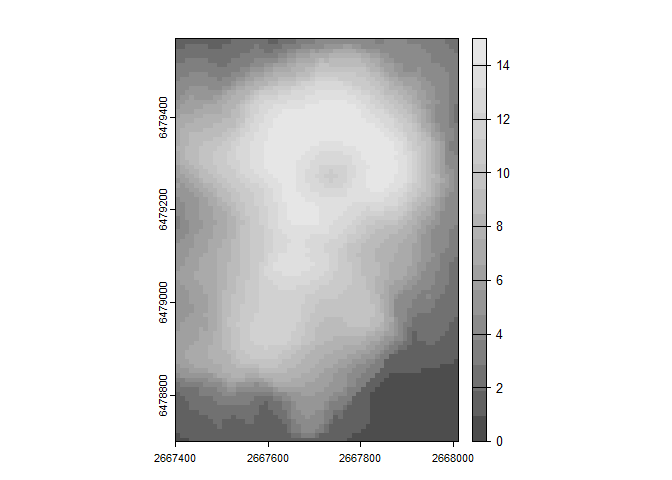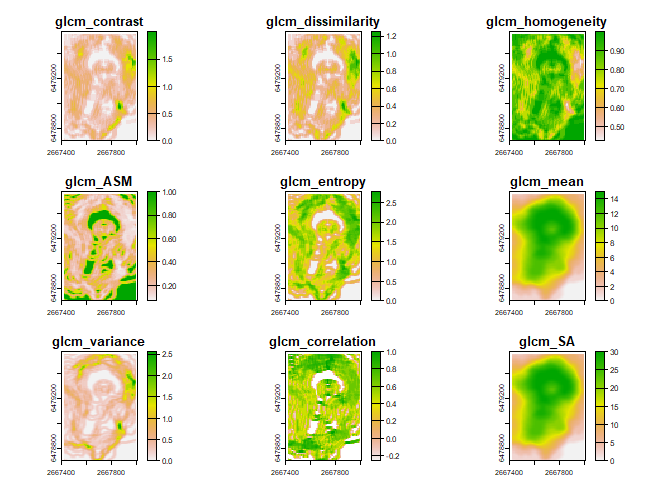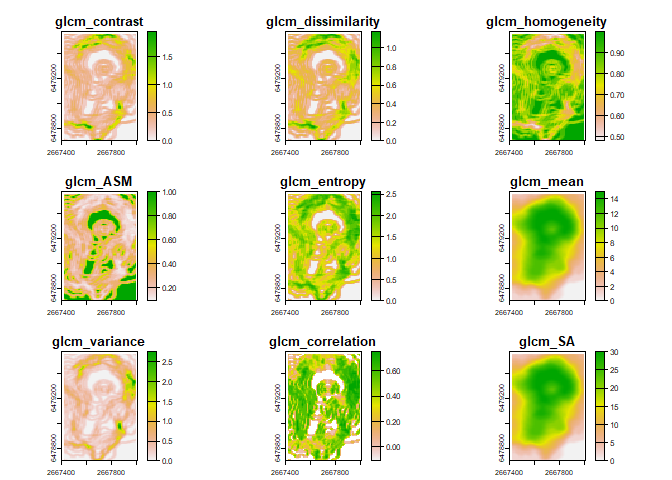
Alexander Ilich April 29, 2025
Ilich, Alexander R. 2020. “GLCMTextures.”, https://doi.org/10.5281/zenodo.4310186. https://github.com/ailich/GLCMTextures.
This R package calculates the most common gray-level co-occurrence matrix (GLCM) texture metrics used for spatial analysis (Hall-Beyer 2017). It interfaces with C++ via the Rcpp and RcppArmadillo packages for increased speed.
Texture metrics are calculated using a symmetric gray level co-occurence matrix (GLCM), meaning that each pixel is counted as a focal and neighboring pixel. For more details on how a symmetric GLCM is constructed, I highly recommend checking out Dr. Mryka Hall-Beyer’s GLCM texture tutorial.
When comparing results across different software that calculate GLCM texture metrics, there are inconsistencies among results. This package is meant to provide a clearly documented implementation of GLCM texture metrics that gives the user control over key parameters to make it clear to the user exactly what they are calculating. As such, the formulas for each texture metric are provided, different shifts can be specified, the user can decide how to handle NA values, and the user gets control over how and if the data should be quantized.
The package can be installed from CRAN using
install.packages("GLCMTextures") or the development version
can be installed from github using the code
remotes::install_github("ailich/GLCMTextures"). If you are
using Windows, you may need to install Rtools using the instructions
found here). To
install from github you must already have the remotes package installed,
which can be installed using
install.packages("remotes")
This package relies on the terra package for handling of
spatial raster data.
The convention for specifying the direction of the neighboring pixel
(the shift) is shown in the image below. The blue pixel in the center is
treated as the focal pixel in the example. Shifts are specified as
c(x_shift, y_shift). So, a shift of c(1,0)
refers to a the neighboring pixel being 1 to the right and 0 upwards of
the focal pixel. Since a symmetric GLCM is created, this means each
pixel is counted as both a focal and a neighboring pixel, so it also
tabulates the shift in the opposite direction c(-1,0),
which is the dotted blue line. Therefore, these two shifts will produce
equivalent results. Although neighboring pixels are typically considered
as those one away in a given direction, the shift value can be specified
as any integer value.

There are 8 metrics than can be calculated by this package that can be divided into 3 groups: the contrast group, the orderliness group, and the descriptive statistics group (Hall-Beyer 2017). The formulas provided below are from Hall-Beyer (2017).
N = Number of rows or columns in the GLCM (Equal to the number of gray levels)
i = row indices of the GLCM matrix (equal to gray level of reference cell)
j = column indices of the GLCM matrix (equal to gray level of neighboring cell)
Pi,j = Probability (relative frequency) of neighboring cells having gray levels i & j
\[\text{GLCM Contrast} = \sum_{i,j=0}^{N-1} {P_{i,j}(i-j)^2}\]
\[\text{GLCM Dissimilarity} = \sum_{i,j=0}^{N-1} {P_{i,j}|i-j|}\]
\[\text{GLCM Homogeneity} = \sum_{i,j=0}^{N-1} \frac{P_{i,j}}{1+(i-j)^2}\]
\[\text{GLCM Angular Second Moment (ASM)} = \sum_{i,j=0}^{N-1} {P_{i,j}^2}\]
\[\text{GLCM Entropy} = \sum_{i,j=0}^{N-1} {P_{i,j}[-ln(P_{i,j})]} \text{ where } 0*ln(0)=0\]
\[\text{GLCM Mean} (\mu) = \sum_{i,j=0}^{N-1} i(P_{i,j})\]
\[\text{GLCM Variance} (\sigma^2) = \sum_{i,j=0}^{N-1} P_{i,j}(i-\mu)^2\]
\[\text{GLCM Correlation} = \sum_{i,j=0}^{N-1} {P_{i,j} \frac{(i-\mu)(j-\mu)}{\sigma^2}}\]
Load packages
library(GLCMTextures) #Load GLCMTextures packageSee package help page
help(package="GLCMTextures")Before conducting texture calculations on entire raster data sets, we will work with a small matrix.
test_matrix<- matrix(data=c(2,0,1,3,0,0,0,3,2), nrow = 3, ncol=3)
print(test_matrix)## [,1] [,2] [,3]
## [1,] 2 3 0
## [2,] 0 0 3
## [3,] 1 0 2This test matrix has 3 rows and 3 columns and contains values from 0-3 (4 gray levels).
We can use themake_glcm function to create a normalized
symmetric GLCM.
A GLCM is a tabulation of counts and has the dimensions of the number of gray levels. The GLCM is initialized with all zeros and then we add as we tabulate counts.
Initialzed GLCM
## [,1] [,2] [,3] [,4]
## [1,] 0 0 0 0
## [2,] 0 0 0 0
## [3,] 0 0 0 0
## [4,] 0 0 0 0The row and column number refers to the gray value of the focal and
neighboring pixel (Since gray levels start at a value of 0, the
row/column number is 1 larger than the corresponding gray level).We will
use a shift of c(1,0) meaning that the neighboring pixels
is the pixel directly to the right of the focal pixel. We start in the
top left corner and we can see that we have a 2 as the focal value and a
3 as the neighboring value directly to the right, so we add 1 to the
corresponding position in the GLCM which is row 3 (2+1)/column 4(3+1).
Since we would like to create a symmetric GLCM where each pixel is
treated as both a focal and neighbor value, we also add to row 4/column
3.
## [,1] [,2] [,3] [,4]
## [1,] 0 0 0 0
## [2,] 0 0 0 0
## [3,] 0 0 0 1
## [4,] 0 0 1 0We then continue this process throughout the whole image, moving right to the next focal pixel, and down to start the next row when a given row is completed. The resulting GLCM is a square matrix of counts that is symmetric about the diagonal.
horizontal_glcm<- make_glcm(test_matrix, n_levels = 4, shift = c(1,0), normalize = FALSE)
horizontal_glcm## [,1] [,2] [,3] [,4]
## [1,] 2 1 1 2
## [2,] 1 0 0 0
## [3,] 1 0 0 1
## [4,] 2 0 1 0Once we have finished tabulating all the counts we “normailize” the GLCM by dividing the each element by the sum of all the counts to get relative frequencies or probabilities that a given pixel of value i occurs next to a pixel of value j. The values in a normalized GLCM will therefore sum to 1.
horizontal_glcm<- horizontal_glcm/sum(horizontal_glcm)
horizontal_glcm## [,1] [,2] [,3] [,4]
## [1,] 0.16666667 0.08333333 0.08333333 0.16666667
## [2,] 0.08333333 0.00000000 0.00000000 0.00000000
## [3,] 0.08333333 0.00000000 0.00000000 0.08333333
## [4,] 0.16666667 0.00000000 0.08333333 0.00000000This could be accomplished in one line of code by setting the
argument normalize=TRUE which is the default.
make_glcm(test_matrix, n_levels = 4, shift = c(1,0), normalize = TRUE)## [,1] [,2] [,3] [,4]
## [1,] 0.16666667 0.08333333 0.08333333 0.16666667
## [2,] 0.08333333 0.00000000 0.00000000 0.00000000
## [3,] 0.08333333 0.00000000 0.00000000 0.08333333
## [4,] 0.16666667 0.00000000 0.08333333 0.00000000You may have noticed that pixels in the last column of the test matrix did not have a neighboring pixel to the right, so you would not tabulate any counts in those cases; however, this is precisely why we tabulate a symmetrical GLCM as these pixels do have neighbors to the left. Also, note that although the original matrix was 3x3, the GLCM is 4x4 because the size of the GLCM corresponds to the number of gray levels, not the size of the input matrix.
Once the GLCM has been constructed, we can use this to calculate
texture metrics using theglcm_metrics function to calculate
the GLCM texture metrics.
glcm_metrics(horizontal_glcm)## glcm_contrast glcm_dissimilarity glcm_homogeneity glcm_ASM
## 4.000000 1.666667 0.400000 0.125000
## glcm_entropy glcm_mean glcm_variance glcm_correlation
## 2.138333 1.166667 1.638889 -0.220339Now we can move from calculating a single value of a given texture metric to calculating raster surfaces of texture metrics.
r<- rast(volcano, extent= ext(2667400, 2667400 + ncol(volcano)*10, 6478700, 6478700 + nrow(volcano)*10), crs = "EPSG:27200") #Use preloaded volcano dataset as a raster
plot(r) #plot values
Our test image had integer values that range from 0 to 3. Raster data
often represent continuous data that cover a potentially large range and
may not be confined to integer values greater than or equal to zero. The
first step is therefore to quantize the raster image to a discrete
number of gray levels. This can be done using
thequantize_raster function. Typically data are quantized
to 16 (4 bit; 24) or 32 (5 bit; 25) gray levels.
With increasing number of gray levels, the computation cost
increases.
There are two methods of quantization available in the
quantize_raster function. The first way,
quant_method = "range", will create bins that cover a range
of equal size (e.g. if the original data ranged from 0-20 and was
quantized to 4 levels, [0-5) would be reassigned to 0, [5-10) would be
reassigned to 1, [10-15) would be reassigned to 2, and [15-20] would be
reassigned to 4). This is the simplest and most common quantization
method. By default the raster is scaled using the min and max of the
data set, but a max and min value can be supplied to the
max_val and min_val parameters. This may be
more desirable if making comparisons across several different rasters
where you need the gray levels to correspond in a consistent way to the
original data, as you can supply the global max/min or the theoretical
max/min values that could occur.
rq_equalrange<- quantize_raster(r = r, n_levels = 16, quant_method = "range")
plot(rq_equalrange, col=grey.colors(16))
## [1] "Min Val = 0"
## [1] "Max Val = 15"The second way to perform quantization is
quant_method = "prob" which performs equal probability
quantization and will use quantiles (Hyndman and Fan 1996) to create
bins that contain an approximately equal number of samples. This is the
quantization method suggested in the original paper (Haralick and
Shanmugam 1973).
rq_equalprob<- quantize_raster(r = r, n_levels = 16, quant_method = "prob")
plot(rq_equalprob, col=grey.colors(16))
## [1] "Min Val = 0"
## [1] "Max Val = 15"Since we used equal probability quantization, each value has approximately the same count
freq(rq_equalprob)[,c("value", "count")]## value count
## 1 0 304
## 2 1 344
## 3 2 269
## 4 3 313
## 5 4 394
## 6 5 302
## 7 6 340
## 8 7 354
## 9 8 332
## 10 9 342
## 11 10 341
## 12 11 330
## 13 12 321
## 14 13 323
## 15 14 339
## 16 15 359For raster data sets, rather than calculating a single value of the
texture for the entire image, we create a surface that represents the
texture in a given neighborhood around each pixel. To do this we
calculate texture metrics using a rectangular sliding
window of a given size. We start at the top left pixel and treat
that as the central pixel, and specify a window of given dimensions. We
then extract a window of that size around the central pixel (note:
window size must be odd). This extracted window is then run through the
process shown before for test_matrix, and the resulting value of a
texture metric is assigned as the value for the position corresponding
with the central pixel. To do this, we can use
theglcm_textures function.
For example, below we calculate textures using a window size of 3 rows by 5 columns
textures1<- glcm_textures(rq_equalprob, w = c(3,5), n_levels = 16, quant_method = "none", shift = c(1,0))
plot(textures1)
You may have noticed in the example above that
quant_method = "none". This is because we supplied a raster
that was already quantized.
We could instead call the original raster and have it quantized
within the glcm_textures function.
textures2<- glcm_textures(r, w = c(3,5), n_levels = 16, quant_method = "prob", shift=c(1,0))
all.equal(values(textures1), values(textures2))## [1] TRUEWe can also calculate the value of textures across multiple shifts by
supplying a list. In fact, the default is to return
directionally/rotationally invariant textures that are averaged across
all 4 directions
shift = list(c(1, 0), c(1, 1), c(0, 1), c(-1, 1)).
textures3<- glcm_textures(r, w = c(3,5), n_levels = 16, quant_method = "prob", shift = list(c(1, 0), c(1, 1), c(0, 1), c(-1, 1)))
plot(textures3)
Some Other Options
By default all calculated texture metrics are returned; however you
can have only a subset returned by specifying which ones you want using
the metrics argument.
You can also use na.rm to specify how you want to handle
NA values.
Hall-Beyer, Mryka. 2017. “GLCM Texture Tutorial v3.0.
Haralick, Robert M, Karthikeyan Shanmugam, and Its’Hak Dinstein. 1973. “Textural features for image classification.” IEEE Transactions on systems, man, and cybernetics (6):610-621.
Hyndman, Rob J, and Yanan Fan. 1996. “Sample quantiles in statistical packages.” The American Statistician 50 (4):361-365.